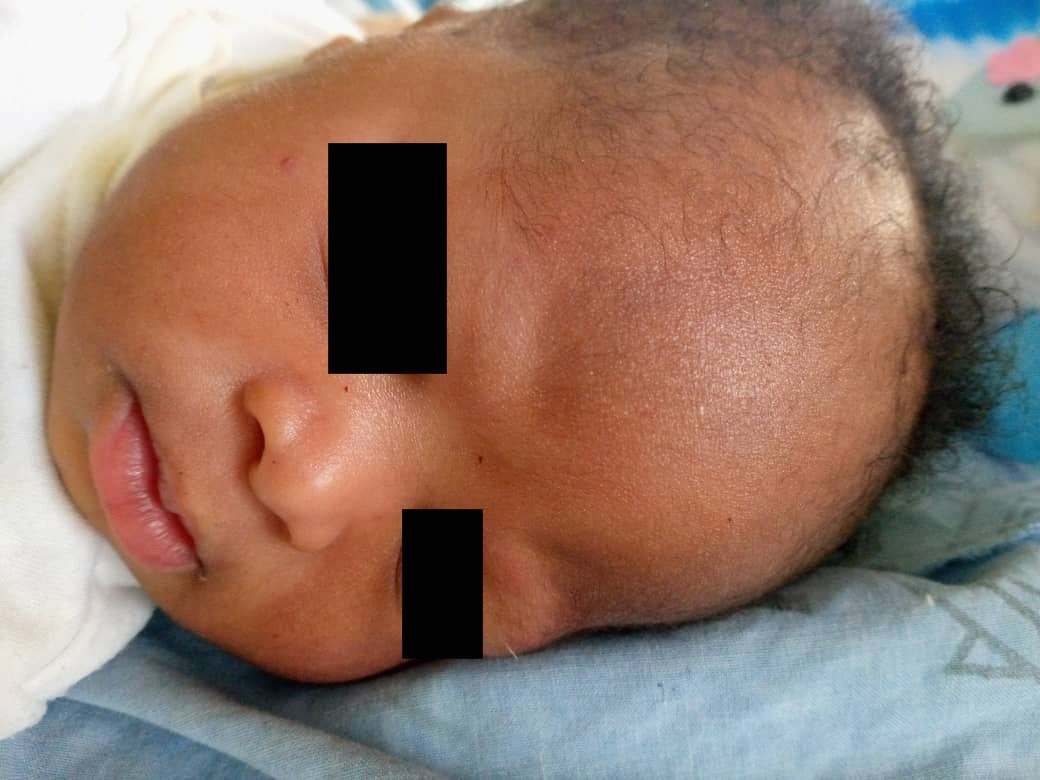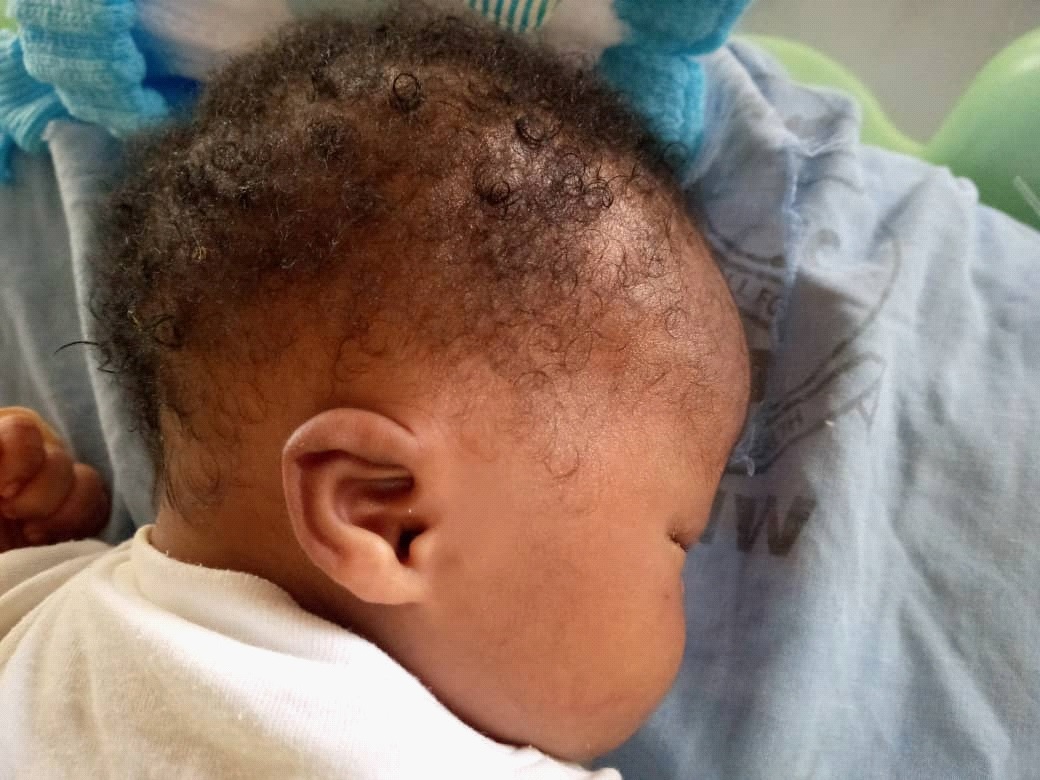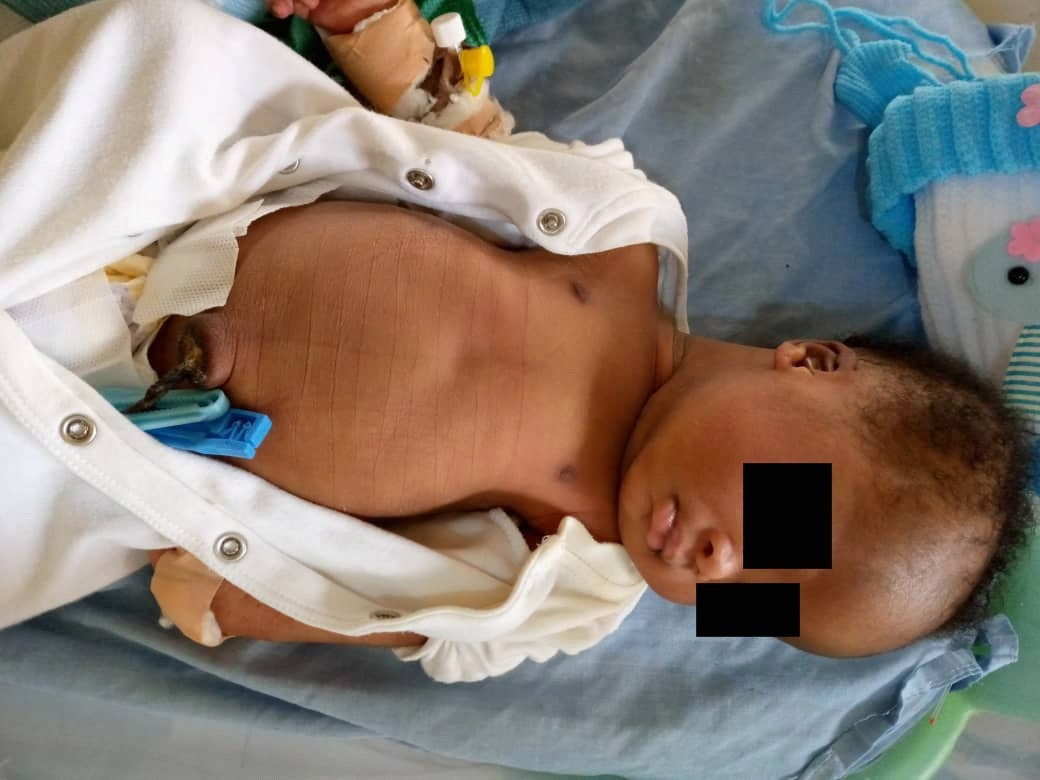
Journal of Clinical Images and Medical Case Reports
ISSN 2766-7820
Case Report - Open Access, Volume 2
Suspected Down Syndrome in one of non-identical twins in Ile-Ife: A case report
Akaninyene Eseme Ubom1*; Omotade Adebimpe Ijarotimi1,2; Michael Sylvester Archibong1; Joseph Osagie Ugowe3
1 Department of Obstetrics, Gynaecology, and Perinatology, Obafemi Awolowo University Teaching Hospitals Complex, Ile-Ife, Osun state, Nigeria.
2 Department of Obstetrics, Gynaecology, and Perinatology, Faculty of Clinical Sciences, College of Health Sciences, Obafemi Awolowo University, Ile-Ife, Osun state, Nigeria.
3 Department of Paediatrics and Child Health, Obafemi Awolowo University Teaching Hospitals Complex, Ile-Ife, Osun state, Nigeria.
*Corresponding Author: Akaninyene Eseme Ubom
Department of Obstetrics, Gynaecology, and Perinatology, Obafemi Awolowo University Teaching Hospitals
Complex, Ile-Ife, Osun state, Nigeria.
Email: bedom2001@yahoo.com & akaninyeneubom@oauthc.com
Received : Aug 23, 2021
Accepted : Sep 21, 2021
Published : Sep 28, 2021
Archived : www.jcimcr.org
Copyright : © Ubom AE (2021).
Abstract
Nigerian women of southwest extraction have the highest rate of dizygotic twinning worldwide, with a reported incidence as high as 49 per 1000 deliveries. Among the risk factors for dizygotic twinning is advanced maternal age, which is also an independent risk factor for Down syndrome (trisomy 21). Down syndrome is the most common chromosomal disorder affecting live born neonates. It occurs very rarely in twins, seen in 14-15 per million non-identical twins. Down syndrome in one of non-identical twins was first reported in Nigeria by Otaigbe in Port Harcourt, in 2007. Herein, we report another case of suspected Down syndrome in one of non-identical twins born to a 41-year-old grand multiparous woman at the Obafemi Awolowo University Teaching Hospitals Complex, Ile-Ife, Osun state, Nigeria.
Keywords: Down Syndrome; dizygotic; fraternal; dichorionic; diamniotic.
Citation: Ubom AE, Ijarotimi OA, Archibong MS, Ugowe JO. Suspected Down Syndrome in one of non-identical twins in IleIfe: A case report. J Clin Images Med Case Rep. 2021; 2(5): 1328.
Introduction
With the increasing practice of assisted reproduction and as more women delay childbearing for various reasons (including career) worldwide, twinning incidence is rising globally [1,2]. The risk of Down syndrome increases with maternal age but occurs rarely in twins [3,4]. We present a case of suspected Down syndrome in one of fraternal twins delivered to a 41-year-old mother.
Case report
Mrs. T. G. was a 41-year-old unbooked G9 P6 +2 with twin gestation. Her pregnancy was spontaneously conceived, and she had received pregnancy care at an unorthodox, faith-based delivery unit in her locality. The only investigation done in the antepartum were two obstetric scans, both of which revealed twin gestation with the leading twin in breech. Other details could not be ascertained. Her pregnancy was uneventful, with no history suggestive of exposure to any known teratogen. She was a petty trader from Ile-Ife, Osun state, married to a 42-yearold driver. She, her husband, and all their other children were phenotypically normal, with no known chromosomal defect. They also had no known family history of chromosomal abnormality.
She presented to our facility at 38 weeks + 5 days with foot prolapse of the leading twin, having been in labour at the unorthodox, faith-based delivery unit, where she had received pregnancy care, where the foot had prolapsed following rupture of foetal membranes. She had emergency Caesarean delivery of dichorionic diamniotic twins. Twin 1 was male, weighed 2.95 kg, with Apgar scores of 7 and 10 at one and five minutes respectively, while twin 2 was female, weighed 2.59 kg, with Apgar scores of 9 and 10 at one and five minutes respectively. The attending neonatologist assessed Twin 1 to have Down syndromelike features including upward slanting palpebral fissures, epicanthal folds, flattened nasal bridge, smooth philtrum, thin upper lip, protruding tongue, low set ears, short and webbed neck, as well as peeling skin, and umbilical hernia (Figures 1-3). Examination of other systems revealed normal findings. Twin 2 was completely normal (Figure 4). Both babies were admitted into the neonatal intensive care unit (NICU) on account of risk of sepsis and congenital abnormality of one twin. In the NICU, Twin 1 was observed to rarely cry, sleeping for most of the time. Owing to financial constraint, patient could not do karyotyping to confirm the clinical suspicion of Down syndrome in Twin 1
Discussion
From the discordant sex and dichorionic diamniotic placentation, the twins were dizygotic. The incidence of dizygotic twinning shows regional variations, with the Yorubas of southwest Nigeria having the highest global incidence, as high as 49 per 1000 live births [1,2]. Kuti et al. reported an incidence of 42.59/1000 deliveries in Ile-Ife, Osun state [5], where our patient hailed from. Grandmultiparity and advanced age were the other predisposing factors to twinning in our patient.
The mechanisms involved in multiple pregnancies equally predispose to various forms of congenital anomaly [2], including trisomy 21 (Down syndrome). The risk of Down syndrome is also independently heightened by increasing maternal age. This risk increases from 1:2000 at 20 years of maternal age, to 1:365, 1:100 and 1:40 at 35, 40 and 43 years respectively [3,4]. Our patient who was 41 years old therefore had a heightened risk of her pregnancy being affected by Down syndrome.
Non-identical twins with Down syndrome occur at the rate of 14-15 per million [2,6], demonstrating its rarity, and hence this report. The occurrence of Down syndrome in one twin of a dizygotic pair is plausibly explained by the fact that in dizygotic twins, each twin has an independent risk for Down syndrome [2]. In about 95% of cases, Down syndrome is due to meiotic nondisjunction resulting in an extra copy of chromosome 21 (trisomy 21), the majority of cases occurring during maternal oogenesis [4,7]. This is because the process of oogenesis is lengthy and involves meiotic arrest, which makes it more vulnerable to malsegregation of chromosomes than spermatogenesis [7]. Advanced maternal age is a risk factor because with increasing maternal age, there is rapid degradation of cellular proteins involved in spindle formation, sister chromatid cohesion or anaphase separation of sister chromatids in oocytes, all of which impose the risk of nondisjunction during meiosis [7].
Typical facies of Down syndrome seen in Twin I included upward slanting of the palpebral fissures, epicanthal folds, depressed nasal bridge, smooth philtrum, thin upper lip, protrusion of the tongue, low set ears, short and webbed neck [2,4]. He also had flaky skin and cried rarely, with umbilical hernia, which is more common in children with Down syndrome. Affected infants may also have associated cardiovascular and gastrointestinal anomalies, as well as developmental and learning difficulties [4]. The psychological, emotional, mental and financial resources expended in the upbringing of such children are enormous. More so for poor parents like our patient and her husband, who were petty trader and driver respectively, with six other children.
Given the foregoing, we cannot overemphasize the benefit of quality antenatal care and the need to routinely offer prenatal screening for Down syndrome to pregnant women with known risk factors. In the developed world, where such diagnosis is made in the antepartum, mothers who do not wish to carry such pregnancies to delivery are offered pregnancy termination. In resource poor settings like ours however, the antenatal screening and diagnostic tests are either non-existent or not readily available. Where available, they are expensive and not affordable by indigent patients like ours. More so, our abortion laws are restrictive, so even where the diagnosis of Down syndrome is made in the antenatal period, our laws do not allow for termination of such pregnancies.
Conclusion
Down syndrome in non-identical twins though rare, is a possible occurrence, the risk increasing with maternal age. For prenatal diagnosis of Down syndrome, our women should be sensitized on the benefit of skilled antenatal care. There is also need to increase the availability and affordability of prenatal screening and diagnostic tests across the country. We recommend that our abortion laws be amended to allow women whose pregnancies are affected by congenital anomalies like Down syndrome the option of pregnancy termination if so desired.
References
- Nwankwo TO, Aniebue UU, Ezenkwele E, Nwafor MI. Pregnancy outcome and factors affecting vaginal deliveries of twins at University of Nigeria Teaching Hospital, Enugu. Niger J Clin Pract. 2013; 16: 490-5.
- Ibrahim A. Dysmorphism in One of a Set of Male Twins; Could They have been Identical Twins? A Diagnostic Dilemma. J Family Med Prim Care. 2014; 3: 281-283.
- Otaigbe BE. Down syndrome in one of non-identical Nigerian twins: A case report. Niger J Med. 2007; 16: 74-76.
- MD Powell-Hamilton, N Nina. Down syndrome (Trisomy 21). The Merck Manual Professional Edition. Merck Sharp & Dohme Corporation, a subsidiary of Merck & Company Inc., Whitehouse Station, NJ, USA. Retrieved from http://www. msdmanuals.com on 06/05/2020.
- Kuti O, Owolabi AT, Fasubaa OB. Outcome of twin pregnancy in a Nigerian Teaching Hospital. Trop J Obstet Gyneacol. 2006; 23: 132-5.
- Buckley SJ. How often are children with Down syndrome twins? Down syndrome News and Update. 2003; 3: 10.
- Ghosh S, Feingold E, kumar Dey S. Etiology of Down Syndrome: Evidence for Consistent Association among Altered Meiotic Recombination, Nondisjunction and Maternal Age Across Populations. Am J Med Genet A. 2009; 149: 1415-1420.




